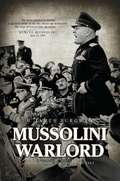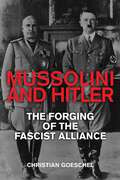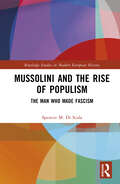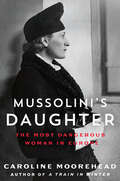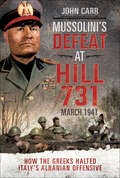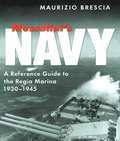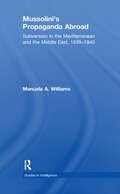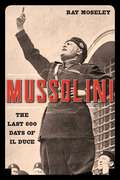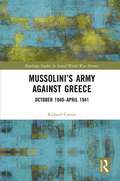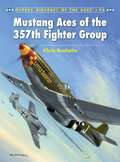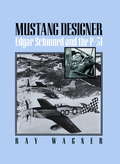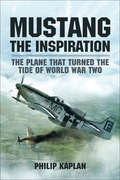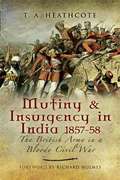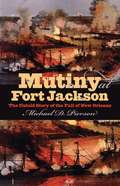- Table View
- List View
Muslims in the West after 9/11: Religion, Politics and Law (Routledge Studies in Liberty and Security)
by Jocelyne CesariThis book is the first systematic attempt to study the situation of European and American Muslims after 9/11, and to present a comprehensive analysis of their religious, political, and legal situations. Since 9/11, and particularly since the Madrid and London bombings of 2004 and 2005, the Muslim presence in Europe and the United States has become a major political concern. Many have raised questions regarding potential links between Western Muslims, radical Islam, and terrorism. Whatever the justification of such concerns, it is insufficient to address the subject of Muslims in the West from an exclusively counter-terrorist perspective. Based on empirical studies of Muslims in the US and Western Europe, this edited volume posits the situation of Muslim minorities in a broader reflection on the status of liberalism in Western foreign policies. It also explores the changes in immigration policies, multiculturalism and secularism that have been shaped by the new international context of the ‘war on terror’. This book will be of great interest to students of Critical Security Studies, Islamic Studies, Sociology and Political Science in general. Jocelyne Cesari is an Associate at Harvard’s Center for Middle Eastern Studies and the Center for European Studies, teaching at Harvard Divinity School and the Government Department, specializing in Islam and the Middle East.
Mussolini Warlord
by H. James BurgwynFascist Italy has received far too little attention in the military history of the Axis partnership. This is the first comprehensive study of Benito Mussolini's military efforts to build an empire during World War II. It details the fascist dictator's attempt to build both a Mediterranean empire and Balkan empire, as well as a narrative history of his tragically flawed illusions; Italy's disastrous military performance; the heroism of Italian soldiers, sailors, and airmen; and the brutal counterinsurgency programs. Italy's various war theaters are discussed singly, with major battles outlined, military aptitude and results judged, and relations with the Axis partner described. Fascist ideology and the Italian army's conduct in the occupied territories--France, Yugoslavia, Albania, Greece, Russia, East Africa, and North Africa--are also analyzed. Mussolini was the single individual most responsible for Italy's failure during World War II. H. James Burgwyn is professor emeritus of history at Westchester University and the author of important works on modern Italian history.
Mussolini and Hitler: The Forging of the Fascist Alliance
by Christian GoeschelThis fresh treatment of Fascist Italy and Nazi Germany reveals how the close relationship between Mussolini and Hitler influenced both men.From 1934 until 1944 Mussolini met Hitler numerous times, and the two developed a relationship that deeply affected both countries. While Germany is generally regarded as the senior power, Christian Goeschel demonstrates just how much history has underrepresented Mussolini’s influence on his German ally.A scholar of twentieth-century Germany and Italy, Goeschel revisits all of Mussolini and Hitler’s key meetings to examine how they constructed a powerful image of a strong Fascist-Nazi relationship that still resonates with the general public. His portrait of Mussolini draws on sources ranging beyond political history to reveal a leader who, at times, shaped Hitler’s decisions and was not the gullible buffoon he’s often portrayed as. The first comprehensive study of the Mussolini-Hitler relationship, this book is a must-read for scholars and anyone interested in the history of European fascism, World War II, or political leadership.
Mussolini and the Rise of Populism: The Man who Made Fascism (Routledge Studies in Modern European History)
by Spencer DiScalaThis book analyzes the process by which Mussolini built the world’s first Fascist regime, describes how the Duce’s heirs have adapted to current political conditions, and how they have gone mainstream. With the rise of populism of the right in the new millennium, Benito Mussolini’s name has returned forcefully to the limelight. Populist movements closely resemble historical fascism, and former President Donald J. Trump has been compared to the Duce. In 2022, the 100th anniversary of the Duce’s taking power, an Italian populist party inspired by fascism took control of the country’s government led by its first woman Prime Minister. By finding in fascism their inspiration to confront the current epoch’s deep transformations, they have taken command in a major European liberal democratic country for the first time since 1945. How this occurred demonstrates the modernity and appeal of Mussolini’s fascism and offers new perspectives in interpreting populism. While the worst elements of fascism have not yet appeared in populist movements, this book conveys in clear language, a more precise awareness of the forces and values that propelled fascism to power and that drive the march of rightist populism worldwide. This volume is essential reading for students, scholars, general observers and commentators interested in European and modern history.
Mussolini's Army in the French Riviera: Italy's Occupation of France
by Emanuele SicaIn contrast to its brutal seizure of the Balkans, the Italian Army's 1940-1943 relatively mild occupation of the French Riviera and nearby alpine regions bred the myth of the Italian brava gente , or good fellow, an agreeable occupier who abstained from the savage wartime behaviors so common across Europe. Employing a multi-tiered approach, Emanuele Sica examines the simultaneously conflicting and symbiotic relationship between the French population and Italian soldiers. At the grassroots level, Sica asserts that the cultural proximity between the soldiers and the local population, one-quarter of which was Italian, smoothed the sharp angles of miscommunication and cultural faux-pas at a time of great uncertainty. At the same time, it encouraged a laxness in discipline that manifested as fraternization and black marketeering. Sica's examination of political tensions highlights how French prefects and mayors fought to keep the tatters of sovereignty in the face of military occupation. In addition, he reveals the tense relationship between Fascist civilian authorities eager to fulfil imperial dreams of annexation and army leaders desperate to prevent any action that might provoke French insurrection. Finally, he completes the tableau with detailed accounts of how food shortages and French Resistance attacks brought sterner Italian methods, why the Fascists' attempted "Italianization" of the French border city of Menton failed, and the ways the occupation zone became an unlikely haven for Jews.
Mussolini's Camps: Civilian Internment in Fascist Italy (1940-1943) (Routledge Studies in the Modern History of Italy)
by Carlo Spartaco CapogrecoThis book—which is based on vast archival research and on a variety of primary sources—has filled a gap in Italy’s historiography on Fascism, and in European and world history about concentration camps in our contemporary world. It provides, for the first time, a survey of the different types of internment practiced by Fascist Italy during the war and a historical map of its concentration camps. Published in Italian (I campi del duce, Turin: Einaudi, 2004), in Croatian (Mussolinijevi Logori, Zagreb: Golden Marketing – Tehnička knjiga, 2007), in Slovenian (Fašistična taborišča, Ljublana: Publicistično društvo ZAK, 2011), and now in English, Mussolini’s Camps is both an excellent product of academic research and a narrative easily accessible to readers who are not professional historians. It undermines the myth that concentration camps were established in Italy only after the creation of the Republic of Salò and the Nazi occupation of Italy’s northern regions in 1943, and questions the persistent and traditional image of Italians as brava gente (good people), showing how Fascism made extensive use of the camps (even in the occupied territories) as an instrument of coercion and political control.
Mussolini's Daughter: The Most Dangerous Woman in Europe
by Caroline MooreheadThe bestselling author of A Train in Winter returns with the definitive story of Mussolini&’s daughter, Edda, one of the most influential women in 1930s Italy, whose life had more twists and turns than a spy novel.Edda Mussolini was Benito's favourite child: spoiled and venal, uneducated but clever, faithless but flamboyant, a brilliant diplomat, wild but brave, and ultimately strong and loyal. For much of the twenty-year period of Fascist rule, she was her father's closest confidante.In 1930, at the age of nineteen, Edda married Count Galeazzo Ciano, who would become the youngest Foreign Secretary in Italian history. Acting as envoy to both Germany and Britain, Edda played a part in steering Italy to join forces with Hitler. During this time, the Cianos became the most celebrated and glamorous couple in elegant, vulgar Roman fascist society.Their fortunes turned in 1943, when Ciano voted against Mussolini in a plot to bring him down, and his father-in-law did not forgive him. Edda's dramatic story includes hidden diaries, her father's downfall and her husband's execution, and an escape into Switzerland followed by a period in exile. Moorehead draws a portrait of a complicated, bold, and determined woman—one who emerges not just as a witness but as a key player in some of the twentieth century's defining moments. And we see Fascist Italy with all its glamour, decadence and political intrigue, and the turbulence before its violent end.
Mussolini's Defeat at Hill 731, March 1941: How the Greeks Halted Italy's Albanian Offensive
by John CarrThis WWII history examines the most consequential and hard-fought battle between Greek and Italian forces in Albania.On March 9th, 1941, the Italians launched their Spring Offensive, designed to stem four months of humiliating reverses. Watched by Mussolini himself, the operation’s objective was a pair of parallel valleys dominated by the Greek-held Hill 731. The Italian Eighth Corps, part of Geloso’s 11th Army, had the task of seizing the heights, spearheaded by 38 (Puglie) Division. Holding the position was the Greek 1 Division of II Corps, with 4 and 6 Division on the flanks.For seventeen days, after a massive artillery barrage, the Italians threw themselves against the Evzones on the hill—only to be repeatedly smashed with appalling losses. It was a merciless fight at close quarters, where bayonets held the place of honor but the battered Greeks held. Mussolini had wanted a spring victory to impress the Führer. Instead, the bloody debacle of Hill 731 could well have contributed to Hitler’s decision to postpone his invasion of Russia. John Carr sheds light on this consequential episode in the Mediterranean theater of operations.
Mussolini's Navy: A Reference Guide to the Regia Marina, 1930–1945
by Maurizio Brescia&“A simply magnificent book describing the Italian Navy of the Second World War, profiling all classes of vessels, from battleships . . . [to] submarines.&” —Pegasus Archive This book is a complete guide to the Regia Marina, the navy with which Italy fought the Second World War. Starting with the historical background, it describes how the navy developed, how it was organized, the facilities that supported it, and the operations it conducted both before and after the armistice in 1943. It also details all its ships, with full technical particulars, plans and photos. Furthermore, there are chapters on special topics like camouflage; uniforms, decorations and insignia; and a &“who&’s who&” of important naval personalities; and the reference value of the book is enhanced by a comprehensive bibliography and guide to sources. The illustration is a noteworthy feature of the book as the author&’s collection of naval photographs is one of the best in Italy. He is also a fine draughtsman, and his ship plans and color illustrations are both detailed and accurate, adding a particular appeal for modelmakers. Of all the main combatant navies of this era, the Italian is probably the most poorly represented in English publications, so this comprehensive handbook will be especially welcomed by the naval community.&“An overview of the wartime Italian Navy, including its bases and organization, ships and aircraft . . . an enjoyable book.&” —Warships International Fleet Review&“A major achievement and a milestone in the renaissance of Italian Naval history . . . [the] book is a gem and is thoroughly recommended.&” —The Navy Vol 75
Mussolini's Propaganda Abroad: Subversion in the Mediterranean and the Middle East, 1935-1940 (Studies in Intelligence)
by Manuela WilliamsThis is the first major study in English of Fascist Italy’s overseas propaganda. Using rare Italian and French captured documents, this is also the first investigation into the relationship between Mussolini’s regime and Arab nationalist movements This new account covers propaganda and subversive activities engineered by the Italian government in the Mediterranean and the Middle East from 1935 until 1940, when Italy entered the war. It assesses the nature of the challenge brought by the Fascist regime to British security and colonial interests in the region. Fascist propaganda, in particular in the Arab Middle East, must be regarded as an expression of Mussolini’s foreign policy and his attempts to build an Italian empire that would stretch beyond the Mediterranean, gaining control over the exits, Gibraltar and Suez, which were in the hands of the British and the French. The activities of individual agents and organizations are carefully reconstructed and analyzed to highlight the seemingly contradictory objectives of the Italian government: on the one hand, Rome was courting the Arab nationalist movements in Egypt and Palestine, which were seeking the support of external forces capable of providing political, financial and military backing needed to overthrow foreign rulers; on the other, the regime was promoting further territorial expansion in Africa. These aspects build into an excellent picture of this fascinating period of modern history. This book will be of great interest to all students and scholars of politics, media, Italian history and propaganda.
Mussolini: The Last 600 Days of Il Duce
by Ray MoseleyIn his last days, Mussolini, the tyrant, was in the grip of anger, shame, and depression. The German armed forces that had sustained his puppet government since its creation in September 1943 were being inexorably driven out of Italy, the frontiers of his Fascist republic were shrinking daily and Mussolini was aware that German military leaders were negotiating with the Allies behind his back in neutral Switzerland. Moseley's well-researched and highly engaging tome throws light on the last twenty months of the despot's life and culminates with the dramatic capture and execution of Mussolini (and his mistress Claretta Petacci) by partisans of the Italian resistance on April 28, 1945.
Mussolini’s Army against Greece: October 1940–April 1941 (Routledge Studies in Second World War History)
by Richard CarrierThis book analyses why the Italian army failed to defeat its Greek opponent between October 1940 and April 1941. It thoroughly examines the multiple forms of ineffectiveness that plagued the political leadership as well as the military organisation. Mussolini’s aggression of Greece ranks among the most neglected campaigns of the Second World War. Initiated on 28 October 1940, the offensive came to a halt less than ten days later; by mid-November, the Greek counter-offensive put the Italian armies on the defensive, and back in Albania. From then on, the fatal interaction between failing command structures, inadequate weapons and equipment, unprepared and unmotivated combatants, and terrible logistics lowered to a dangerous level the fighting power of Italian combatants. This essay proposes that compared to the North African and Russian campaigns where the Regio Esercito achieved a decent level of military effectiveness, the operation against Greece was a military fiasco. Only the courage of its soldiers and the German intervention saved the dictator’s army from complete disaster. This book would appeal to anyone interested in the history of the world war, and to those involved in the study of military effectiveness and intrigued by why armies fail.
Must Love Horses (Lazy S Ranch #2)
by Vicki TharpThe dust hasn’t settled on one woman’s past, but amid the breathtaking hills and valleys of Wyoming’s high country—and with the encouragement of one special man—her spirit won’t be broken . . . Sydney Teller is as determined as the wild mustangs she was raised to train. Her reckless parents destroyed their reputation in the business—and hers, by association—yet Sydney knows she can prove herself, if she’s just given a chance. That where the Lazy S Ranch, and sexy Bryan “Boomer” Wilcox comes in . . . Bryan risked life and limb on his tours in Iraq, and he knows damaged goods all too well when he sees them. Problem is, Sydney looks damn fine in a saddle and she’s got moves that can’t be learned. He doubted her at first, but now he wonders if they can navigate life’s obstacle course together—and indulge their own animal instincts . . . Sydney can’t deny her attraction to Bryan, yet she’s wary of his demons. But when foul play threatens the ranch, and their futures, Bryan gets a chance to rediscover the hero he’s been all along—and Sydney gets to show she’s got what it takes to tame the wildest impulses—in both man and beast . . .
Mustafa Kemal Atatürk
by Adam Hook Edward EricksonMustafa Kemal was one of the 20th century's greatest combat commanders. Born in Salonika to a middle-class family, this book follows the life of a great commander who served in the Italo-Turkish War of 1911-12 and the Balkan Wars of 1912-13 before taking command of the 19th Division based in Gallipoli during World War l. His sterling service led to his promotion to corps command during the fighting against the Russians in the Caucasus. Following the end of the war he took command of the nationalist forces struggling against the occupation of Turkey, and managed to defeat Greek forces that sought to occupy Smyrna, thus preserving Turkey's territorial integrity. Labelled as the 'Man of Destiny' by Winston Churchill, his services in Gallipoli and the War of Independence were pivotal to the success of his armies. After leading the nationalist army to victory, he established the modern Turkish Republic and became Turkey's first ever president taking the name Atatürk, meaning Father of the Turks, as his own.
Mustafa Kemal Atatürk: Heir to the Empire (The World in a Life Series)
by Ryan Gingeras<p>Part of The World in a Life series, this brief text provides insight into the life of Mustafa Kemal Atatürk. By the outbreak of World War II, the Republic of Turkey epitomized more than a state bound for better times; it aspired to represent the essence of modern politics in the twentieth century. To contemporaries of this period, Mustafa Kemal Atatürk--the country's first president--was both the muse and the architect of this radical transformation. By the time of his death in 1938, he was regularly compared alongside other luminary statesmen of the post-Versailles era. Outside of Turkey, his name was synonymous with bold leadership and ambitious reform. Atatürk's reputation as a man both progressive and iconoclastic greatly augmented his already lofty status as Turkey's premier general and war hero. Yet there were some aspects of his life presidency that tempered contemporary admiration for Mustafa Kemal. His acclaim and celebrity came with the understanding that he was a dictator with little patience for liberal democracy. Atatürk's inability to brook compromise and tolerate opposition engendered acts of violence and oppression that resulted in the deaths of large numbers of his fellow citizens. As a whole, the legacies of both his achievements and flaws as a leader remain critical to any understanding of modern-day Turkey. <p>We live in a global age where big concepts like "globalization" often tempt us to forget the personal side of the past. The titles in The World in a Life series aim to revive these meaningful lives. Each one shows us what it was like to live on a world historical stage. Brief, inexpensive, and thematic, each book can be read in a week, fit within a wide range of curricula, and shed insight into a particular place or time. Four to six short primary sources at the end of each volume sharpen the reader's view of an individual's impact on world history.</p>
Mustang Aces of the 357th Fighter Group
by Chris Davey Chris BucholtzThe 357th Fighter Group produced 42 aces, more than any other group within the USAAF. It was also the first group in the Eighth Air Force to be equipped with the P-51. Thanks to this fighter and the talented pilots assigned to the group (men such as Bud Anderson, Kit Carson, John England and Chuck Yeager) the 357th achieved a faster rate of aerial victories than any other Eighth Air Force group during the final year of the war. It also claimed the highest number of aerial kills - 56 - in a single mission. The group was awarded two Distinguished Unit Citations (the unit equivalent of the Medal of Honor). Written by Chris Bucholtz, this book is crammed full of first-hand accounts, superb photography and some of the most colorful profiles to be found in World War II aviation.
Mustang Aces of the Eighth Air Force
by Jerry Scutts Chris DaveyUnquestionably the best American fighter of World War 2, the North American P-51 Mustang served in large numbers with the USAAF's Eighth Air Force from late 1943 until VE Day, and was the mount of most aces in-theatre. Charged with the responsibility of escorting huge formations of B-17 Flying Fortress and B-24 Liberator bombers on daylight raids deep into Germany, the P-51 pilots of the various fighter groups within the 'Mighty Eighth' went head to head with the cream of the Luftwaffe's fighter squadrons for control of the skies over the Third Reich.
Mustang Creek Manhunt
by Janice Kay JohnsonShe didn&’t know her protection had just become his number one priority… Sheriff Boyd Chaney swore to protect his ex, Melinda McIntosh—even when she thinks she doesn't need it. And with a paroled criminal targeting her, he refuses to let the stubborn cop be next on the murderer's revenge list. Officers and their loved ones are being killed and the danger is closing in—as is their undeniable attraction. But will their resurrected partnership be enough to keep them safe? From Harlequin Intrigue: Seek thrills. Solve crimes. Justice served.
Mustang Designer
by Ray WagnerMustang Designer tells the story of American wartime fighter development, including engines and armaments, as part of a nationwide program of aircraft builders and fliers, focusing on Edgar Schmued, the designer of the Mustang. The P-51 Mustang is widely regarded as the best propeller-driven fighter that ever flew. What many might not realize is that the plane's developer was a German migrant. This book tells of how Schmued created a weapon that would ultimately prove lethal to the aspirations of those who had seized control over his native land.
Mustang and Thunderbolt Aces of the Pacific and CBI
by Tom Tullis John StanawayAlthough far better known for their exploits over the war torn skies of Germany and Italy, the USAAF's premier fighters, the P-47 and P-51, also made significant contributions to the victory against Japan from 1943 onwards. This book relates the appearance of the Allison-engined A-36As and P-51As over Rangoon from India in November 1943, the 1st Air Commando Group in China, P-47s over the jungles of New Guinea in 1943, escorting B-29s on long-range bombing sorties against the Home Islands in 1944-45 and elsewhere.
Mustang the Inspiration: The Plane That Turned the Tide of World War Two
by Philip KaplanIf it looks right, it will probably fly righta tired old saying among airmen, but one that persists. Think if you will of the handful of aeroplanes that most people would probably agree are the best-looking examples of all. The list is short but distinguished and the proof is in the enthusiastic common view of most pilots who have flown themfor nearly all, it was love at first sight and first flight. For most that little list includes the Vickers-Supermarine Spitfire, the Douglas DC-3, the Hawker Hunter, the Lockheed Constellation, the Concord, and the North American Mustang. Of these, the Spitfire and Mustang stand out and remain extra special to the majority of pilots who have been privileged to fly them. One common thread exists among those who have experienced both of these fine machines; an opinion that seems to hold up even after a lifetime of flying the best the aviation design community has created. While the Spitfire may have a slight edge in light-touch handling, if I have to go to war in one type, Ill take theMustang every time.This comprehensive account of the Mustang aircraft charts the operational history of the craft and also relays a the personal stories and experiences of the men who flew the 'Cadillac of the skies' as it has been described. A vivid and enthralling history set to appeal to aviation enthusiasts looking for more than just a mere operational history of the Mustang's exploits.
Muthal Ulaga Por
by MarudhanThis book narrates the history of World War I in four parts, viz., the causes, the war path, the Battle field, and the Destruction.
Mutiny & Insurgency in India, 1857–58: The British Army in a Bloody Civil War
by T. A. HeathcoteA vivid account of the bloody rebellion against colonial rule that raged through Northern India in the mid-nineteenth century. In 1857, a mutiny against the British East India Company broke out in the Bengal Army that would soon spread to Delhi and beyond. The cycle of bloody reprisals would continue for a little over two years, leaving countless bodies in its wake. The events of 1857 to 1859 were tragic and momentous. The challenge to British colonial rule was on an unprecedented scale. This book places these grim events into their historical, political, and economic contexts, and the authors&’ use of sources including personal accounts brings events of over a century and a half ago vividly to life.
Mutiny & Insurgency in India, 1857–58: The British Army in a Bloody Civil War
by T. A. HeathcoteA vivid account of the bloody rebellion against colonial rule that raged through Northern India in the mid-nineteenth century. In 1857, a mutiny against the British East India Company broke out in the Bengal Army that would soon spread to Delhi and beyond. The cycle of bloody reprisals would continue for a little over two years, leaving countless bodies in its wake. The events of 1857 to 1859 were tragic and momentous. The challenge to British colonial rule was on an unprecedented scale. This book places these grim events into their historical, political, and economic contexts, and the authors&’ use of sources including personal accounts brings events of over a century and a half ago vividly to life.
Mutiny at Fort Jackson
by Michael D. PiersonNew Orleans was the largest city--and one of the richest--in the Confederacy, protected in part by Fort Jackson, which was just sixty-five miles down the Mississippi River. On April 27, 1862, Confederate soldiers at Fort Jackson rose up in mutiny against their commanding officers. New Orleans fell to Union forces soon thereafter. Although the Fort Jackson mutiny marked a critical turning point in the Union's campaign to regain control of this vital Confederate financial and industrial center, it has received surprisingly little attention from historians. Michael Pierson examines newly uncovered archival sources to determine why the soldiers rebelled at such a decisive moment.The mutineers were soldiers primarily recruited from New Orleans's large German and Irish immigrant populations. Pierson shows that the new nation had done nothing to encourage poor white men to feel they had a place of honor in the southern republic. He argues that the mutineers actively sought to help the Union cause. In a major reassessment of the Union administration of New Orleans that followed, Pierson demonstrates that Benjamin "Beast" Butler enjoyed the support of many white Unionists in the city.Pierson adds an urban working-class element to debates over the effects of white Unionists in Confederate states. With the personal stories of soldiers appearing throughout, Mutiny at Fort Jackson presents the Civil War from a new perspective, revealing the complexities of New Orleans society and the Confederate experience.

